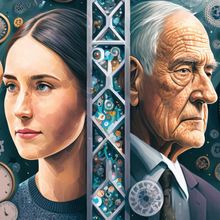cholesterol

The Promise of RNAi Therapeutics for Cardiovascular Disease Treatment
The Scientist Staff | Oct 23, 2024 | 5 min read
Kevin Fitzgerald from Alnylam Pharmaceuticals explains the potential of RNA interference for treating disease and highlights recent clinical trial successes.

How the Crimean Congo Virus Sneaks into Cells
Maggie Chen | Jul 15, 2024 | 4 min read
A tickborne virus uses cholesterol receptors to worm its way into the cell.

An Epigenetic Strategy to Control Bad Cholesterol
Maggie Chen | Apr 12, 2024 | 3 min read
Modifying markers on DNA allows scientists to lower cholesterol levels in mice, even long-term.

Daily Gene Expression Rhythms Vary with Sex and Age: Study
Alejandra Manjarrez, PhD | Feb 2, 2023 | 3 min read
By studying tissues from deceased people, a team found that women have more rhythmical gene expression and that this molecular rhythmicity decreases with age.

Viral Protein Behind Chronic Inflammation in People with HIV: Study
Natalia Mesa, PhD | Dec 12, 2022 | 3 min read
The HIV protein Nef can cause long-term genetic changes that lead to hyperreactive immune cells, according to research in human cells and mice.

A Gene Variant Linked to Alzheimer’s May Disrupt Myelin Production
Andy Carstens | Nov 22, 2022 | 5 min read
The APOE4 variant causes cholesterol buildup in the cells that make protective fatty sheaths for neurons, possibly helping explain its role in neurodegeneration.

Astrocytes Feed Glioblastoma, Promoting Tumor Growth: Mouse Study
Patience Asanga | Oct 5, 2022 | 3 min read
Starving glioblastoma tumors of the cholesterol made by astrocytes could suppress brain cancer progression.

The Scientist Speaks - What Comes Up Must Go Down: Maintaining Hormone Balance Through RNA Decay
The Scientist | Sep 22, 2022 | 1 min read
Neelanjan Mukherjee discusses how RNA decay is essential for regulating a blood pressure-controlling hormone.

First Person Dosed in Novel Gene Editing Clinical Trial
Amanda Heidt | Jul 12, 2022 | 4 min read
The biotech company Verve Therapeutics launched the study with the aim of using base editing to treat a genetic condition that causes high cholesterol and increases a person's risk of developing cardiovascular disease.

How the Sea Cucumber Defends Itself . . . From Itself
Natalia Mesa, PhD | Jul 1, 2022 | 3 min read
The marine animals have evolved a unique molecular pathway enabling them to use toxins to fight off invaders without poisoning themselves in the process.

Breast Cancer Cells Churn Out Cholesterol to Fuel Metastasis
Alejandra Manjarrez, PhD | Feb 4, 2022 | 4 min read
A study uncovers a novel connection between the biomolecule and cancer progression.

Genetic Variant Discovered in Amish Protects from Heart Disease
Abby Olena, PhD | Dec 2, 2021 | 3 min read
Researchers link a missense mutation in the B4GALT1 gene to lower levels of LDL cholesterol and the blood clotting factor fibrinogen.

High-Quality Screening and Target Validation During Drug Development
The Scientist Creative Services Team in collaboration with Thermo Fisher Scientific | Oct 18, 2021 | 1 min read
Drew Adams will discuss his work developing therapeutics that promote remyelination for neurological diseases.

Infographic: Pathways from Noise to Cardiovascular Damage
Thomas Münzel and Omar Hahad | Jun 1, 2021 | 2 min read
Research in mice and humans points to oxidative stress and inflammation as likely drivers of noise-induced health effects such as hypertension and heart disease.

How Environmental Noise Harms the Cardiovascular System
Thomas Münzel and Omar Hahad | Jun 1, 2021 | 10+ min read
Sound from cars, aircraft, trains, and other man-made machines is more than just annoying. It increases the risk of cardiovascular disease.

Robert Simoni, Cellular Membrane Biochemist, Dies at 81
Amanda Heidt | Sep 25, 2020 | 3 min read
Simoni spent more than four decades at Stanford University as a teacher, researcher, and administrator in the university’s biology department.

Could Statins Reduce the Severity of COVID-19?
Ashley Yeager | Jun 12, 2020 | 7 min read
The cholesterol-lowering drugs quell inflammation and reverse endothelial tissue damage, hints that they might curb the body’s excessive immune response to SARS-CoV-2 infection.

Novartis’s $9.7 Billion Purchase Includes Novel PCSK9 Inhibitor
Emily Makowski | Nov 25, 2019 | 2 min read
The pharmaceutical firm is buying The Medicines Company, which recently devoted its efforts into developing the cholesterol-lowering medication.

Study of Ugandan Genomes Yields Novel Variants, Health Links
Shawna Williams | Oct 31, 2019 | 2 min read
The authors say their results demonstrate the global benefits of studying African genetics.
